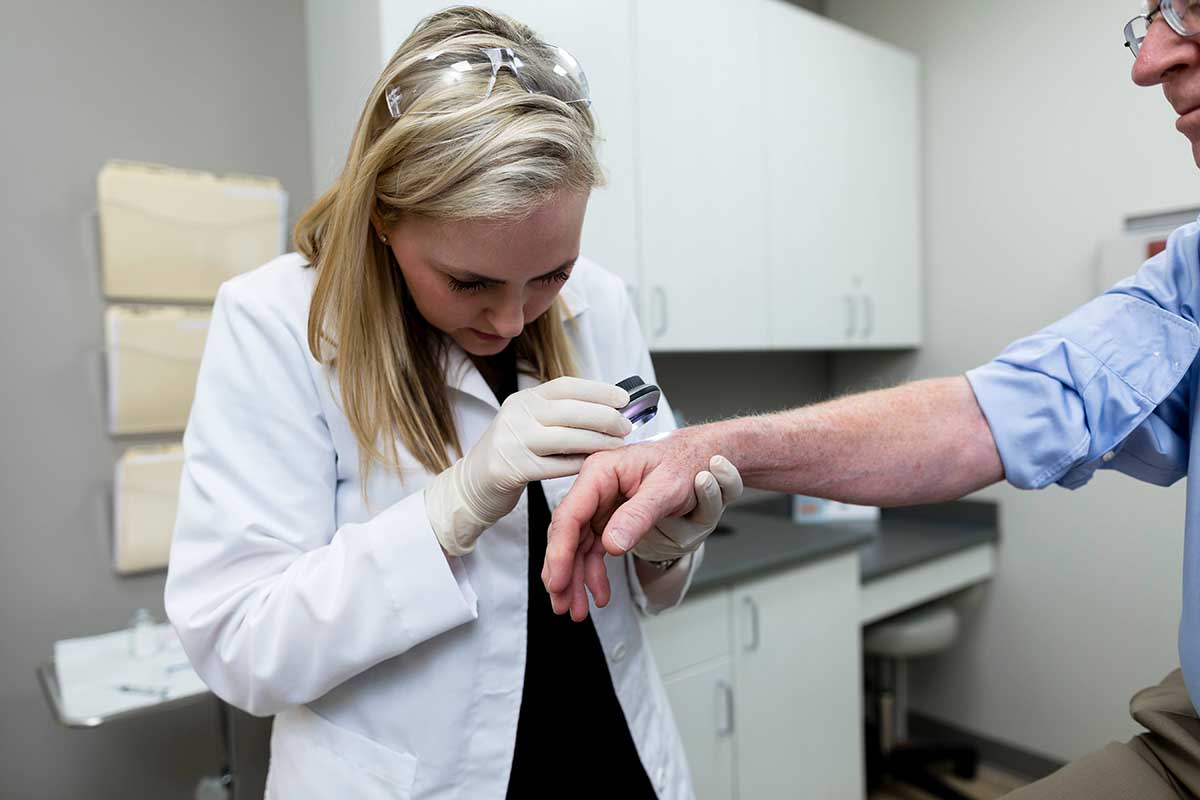Full-Body Skin Exams and Skin Cancer Screenings
Some of the most frequent requests that we receive at MOD Dermatology in Omaha are for skin exams, skin cancer treatment, and screenings. According to the American Academy of Dermatology, one in five Americans will develop skin cancer in their lifetime. Everyone is at risk of developing skin cancer, no matter their skin color. As you age, frequent skin exams are essential to increasing your chances of spotting skin cancer early. If your family has a history of skin cancer or you think you may have melanoma, our Omaha-based dermatologists are here to offer screenings and treatments personalized to you.
Dr. Melanie Ortleb and Physician Assistant Amy K. Price perform full-body skin exams in Omaha at MOD Dermatology. Skin exams are recommended for patients with a history of multiple or atypical moles, pre-cancers, cancerous spots, basal cell or squamous cell skin cancer, melanoma, and other health problems that could place them at a higher risk of developing skin cancer.

Who should consider scheduling a full-body skin examination?
While all skin types are susceptible to getting skin cancer, there are several variables that may put you at a higher risk. If you fall into one of the following categories, you should consider scheduling a full-body skin exam at our Omaha location:
- Anyone wanting a baseline skin examination and teaching on what is important to watch for on your skin
- Anyone with a history of actinic keratosis, precancerous areas, basal cell carcinoma, or squamous cell carcinoma
- Anyone with a history of melanoma
- Anyone with a family history of melanoma
- Anyone with atypical nevi or “moles”
- Anyone with a history of tanning bed use or outdoor tanning
- Anyone who has had multiple sunburns
- Anyone with frequent sun exposure or an outdoor occupation
What to Expect During a Skin Exam
The thought of having all of your skin examined by someone can be stressful for some people, especially when they’re unsure of what to expect. We try to make the experience as comfortable as possible for you by providing a gown and keeping you strategically covered throughout the exam. Skin cancer can develop anywhere on the body—from your scalp to the soles of your feet—which is why it’s important to have a full-body skin cancer screening. However, while Dr. Melanie Ortleb and Physician Assistant Amy K. Price prefer to look at all of your skin, you can undress to a level that makes you most comfortable.
During your full-body skin exam, your dermatologist will use a dermatoscope, which looks like a mix between a flashlight and a microscope, to examine moles and lesions more closely. If any suspicious spots or moles are found, your provider will determine whether they need to be monitored or removed. Biopsies may be performed from skin and sent for testing to determine malignancy. At MOD Dermatology in Omaha our melanoma and skin growth biopsy procedures are designed to be as comfortable as possible for our patients.
How to do a self-skin exam
Even though you’ll likely only need a dermatologist-provided skin exam once per year, you should make it a habit to do self-skin exams once per month. Doing these regularly will help you keep track of any changes in moles and help you catch concerning spots early.
Here’s how to perform a skin exam on yourself:
Go to a well-lit room in front of a mirror. Use a hand-held mirror to make it easier to see areas like the backs of your legs, neck, and torso. A close friend, partner, or family member can help you check the hard-to-see areas like your scalp.
Take note of the way your moles, freckles, and other spots are shaped, sized, and colored. Taking mental notes or photos can help you notice any changes that occur between exams.
As you begin your exam, start with your face, ears, neck, chest, and stomach. Then check your underarms, the front and back of your arms, the tops and palms of your hands, between your fingers, and under your fingernails. Make sure to check the skin underneath breasts and skin folds.
Sitting down, you’ll then check your legs, including the tops of your thighs, shins, feet, between the toes, and under toenails. Then, use your hand mirror to check the bottom of your feet, calves, and the back of your thighs.
Next, you’ll stand again and use the hand mirror to check your buttocks, genital areas, and lower back. You’ll also check the back of your neck, ears, and upper back—these areas can be easier to exam if you use your hand mirror to reflect in a larger wall mirror.
Finally, check your scalp in sections using a small comb.
What should I look for during a self-skin exam?
During your self-skin exam, here are a few things you will want to check for and make note of:
- Any moles, spots, or growths that have newly appeared or changed in size, shape, or color since your last exam
- A wound or sore that bleeds and doesn’t heal after several weeks
- A scaly, rough, or irritated patch that gets crusty or bleeds
- Any wart-like growths
- Moles that are asymmetrical, have uneven borders, are multiple colors, are larger than the size of a pencil eraser in diameter, or have evolved in size, shape, color, or other symptoms over time. A good way to remember these warning signs is “ABCDE,” standing for asymmetry, border, color, diameter, and evolving.
Full-Body Skin Exams and Skin Cancer Screenings in Omaha
Need to schedule your annual skin cancer screening or have concerns you would like to discuss with a board-certified dermatologist? Call 402-505-8777 to schedule a visit with any of our providers.




